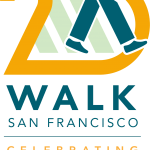Autonomous vehicles: Are they taking us where we want to go?
When Walk San Francisco was founded 20 years ago, no one could have anticipated that our organization would someday face this question: if autonomous vehicles become a reality, how can we ensure they truly protect pedestrians?
Yet here we are, with autonomous vehicles (AVs) in development and being tested on our streets. Tragically, the first AV-caused pedestrian death occurred in Arizona just three months ago.
Safety must come first
Human error is the cause of 9 out of 10 crashes, so we do see potential for AVs making streets safer. But this will only happen if they are actually held to a very high standard. Currently, car manufacturers get to decide when a vehicle is safe enough for our roads. That’s unacceptable.
That’s why Walk San Francisco is pushing for a rigorous (and not rushed) federal policy on AVs with the national organization Advocates for Highway & Auto Safety. Most importantly, this policy would include requiring autonomous vehicles to pass a “vision test” that proves they can detect people walking and biking — and react to them. It would also include other important provisions, such as providing wheelchair access in a sufficient number of vehicles.
We’re also advocating for autonomous vehicle policy to go further. These vehicles can only be truly safe for people walking and biking if they are programmed to prioritize the safety of people outside the vehicle. This means they would swerve to miss hitting a pedestrian *even* if it meant a worse crash for the vehicle. It could also mean things like programming the vehicle to minimize left turns, which are a top factor in pedestrian crashes. Policy has to do this, as the market may not.
And while it’s important for Walk San Francisco to advocate for these policies, we know we don’t need autonomous vehicles to make our streets safe; the tools already exist. This is what we advocate for every day: raised intersections, bulb-outs, curb ramps, traffic circles, narrow traffic lanes, automated speed enforcement, protected bike lanes, and permanently closing some streets to cars altogether.
These are the tools that will make our streets safer — and more inviting — for all of us. These are the tools that we can use today.
Let’s plan for our goals, not our cars
Even if AVs are safe, that’s not enough: a transportation system that prioritizes driving, especially solo driving, is bad for cities and bad for people. The ready availability of autonomous vehicles will create demand for vehicle trips, which will lead to more traffic on our streets. Over time, it could encourage more car-dependent development, which in turn will increase driving as well.
A vehicle-oriented future could also (further) split our transportation system into two: one a comfortable, convenient private system for the affluent; the other, a deteriorating, inefficient public system for working-class and poor people, people of color, immigrants, and the disabled and senior community.
Our cities are already too car-oriented. Let’s not go farther down that road.
Instead, let’s pass policies that prioritize walkable, healthy, just, and sustainable communities. That means centering our transportation system on robust, efficient public transit — both local and regional — together with safe, inviting environments for walking and biking.
Let’s work together to refocus the conversation around creating the kind of transportation system, city, and society we really want. Let’s realize safe and welcoming streets for all today, not in 5, 10, or 20 years when autonomous vehicles “save” us. We’ll be meeting with the Mayor-Elect as soon as possible to talk about how they can lead on Vision Zero and make our streets safe—now.




